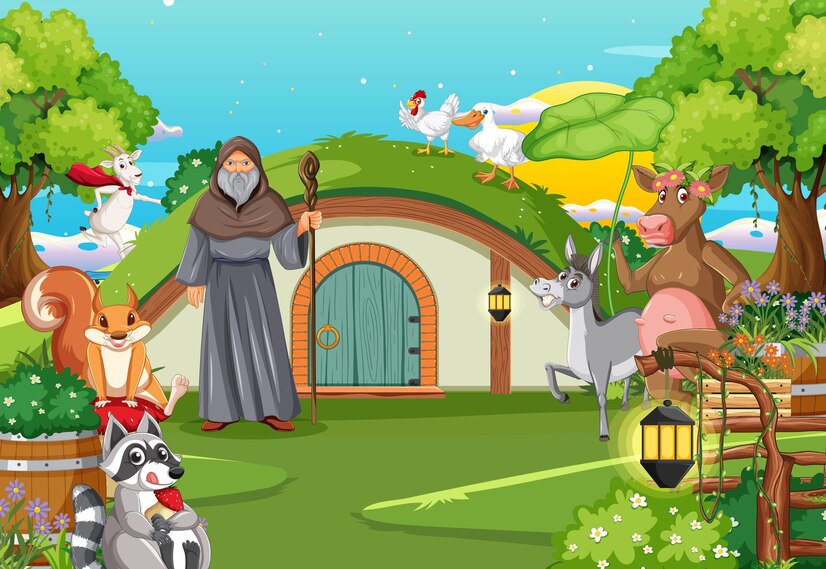
Introduction
Stories have the extraordinary power to mould our lives when interwoven with time-old morals. Hindi moral stories, mostly from folklore and ancient literature such as Panchatantra and Hitopadesha, have played an important role in transmitting values across generations. These culturally significant tales entertain and help develop virtues such as honesty, patience, and teamwork. Let’s explore the Top 10 Moral Stories in Hindi that change one’s life.
Why Stories Have the Power to Educate Us
But let’s get to the list before we dive into the context. Here’s a thought: Why do stories stick with us long after we’ve read them? It is because stories weave life lessons about plots, characters, and emotions while not giving ordinary advice or instructions.
Stories paint vivid pictures of ‘right’ and ‘wrong’ and let us see ourselves in these lessons. In Indian culture, Hindi stories are important in passing down values and traditions from generation to generation.
With these stories, you will learn from stories of kindness, resilience, respect, humility, gratitude, and so much more.
Top 10 Moral Stories in Hindi
1. पंचतंत्र कहानी: बन्दर और मगरमच्छ (The Monkey and the Crocodile)

In this very popular Panchatantra story, a smart monkey befriends a crocodile. But the wife of the crocodile asks for his heart as her meal. The monkey is stuck in this difficult situation, so he makes the crocodile take him back to the tree, saying that his heart is there. Having safely reached the tree, he warns the crocodile never to betray anybody again and breaks the friendship.
Moral: In danger, wit and presence of mind can save lives.
This story teaches us the importance of quick thinking and caution in relationships. Trusting unquestioningly can lead to betrayal in business, friendships, or personal life.
2. ईमानदार लकड़हारा (The Honest Woodcutter)

Once, a poor woodcutter accidentally drops his axe into a river. A deity appears and offers him a golden axe and a silver axe. The woodcutter refuses, stating they aren’t his. Impressed by his honesty, the deity rewards him with all three axes.
Moral: Honesty is always rewarded.
In today’s fast-paced world, honesty is a lost virtue. But this tale reminds us that truthfulness can open the most unexpected doors of opportunity and goodwill.
3. लोमड़ी और अंगूर (The Fox and the Grapes)

A hungry fox sees a bunch of grapes hanging high on a vine. It tries hard but cannot reach them. Frustrated, the fox walks away, saying that the grapes are sour anyway.
Moral: It’s easy to despise what you cannot achieve.
This fable reflects human behaviour in case of failure. Instead, we should not degrade our failures; we should find out where we went wrong and improve it.
4. कबूतरों का झुंड और शिकारी (The Pigeons and the Hunter)

In this story, a hunter catches a group of pigeons in a net. Under their king’s leadership, the pigeons decide to fly together, raising the net and flying away. They later take the assistance of a rat to break free.
Moral: Unity is strength.
The lesson is clear: teamwork can overcome even the gravest challenges. Sticking together during tough times is the key to success in workplaces, families, or communities.
5. सच्चे दोस्त (True Friends)

Two friends walking through a forest encounter a bear. One climbs a tree to save himself, leaving the other behind. The abandoned friends are still pretending to be dead. The bear sniffs him and leaves, thinking he’s lifeless. After the danger passes, the friend on the ground remarks that true friends don’t abandon each other.
Moral: True friends stand by you in times of need.
This story underscores the importance of loyalty and trust in friendship. Real friendships are based on mutual care and not self-interest.
6. कौए और घड़ा (The Crow and the Pitcher)

The Thirsty Crow story is one of the most well-known Aesop Fables, widely translated and adapted into many languages, including Hindi. One day, a crow comes across a pitcher containing very little water at the bottom. The crow tries several times to drink from the pitcher, but the water is too low for him to reach.
After failing repeatedly, the crow comes up with a new idea. He begins dropping small pebbles into the pitcher, one by one. Gradually, the water level rises, and eventually, the crow can drink and quench his thirst.
Moral: Where there’s a will, there’s a way.
This story beautifully illustrates the importance of problem-solving and persistence. Challenges are inevitable in life, but with determination and creativity, even the toughest obstacles can be overcome.
7. बुढ़िया और जादुई घड़ा (The Old Woman and the Magic Pot)

An old poor woman, in a story, found a magic pot that would double all things placed inside it. Over time, she turned greedy and began hoarding the wealth. She fell into the pot one day, and her greed proved her downfall.
Moral: Greed leads to ruin.
This story portrays the destructive nature of greed and highlights the importance of contentment. It reminds us that true happiness lies in appreciating what we have rather than constantly chasing more.
8. हाथी और उसके दोस्त (The Elephant and His Friends)

Several animals reject an elephant in the forest because of its size. He eventually proves his worth by protecting them from a predator. The animals then realise the value of having a true friend, irrespective of differences.
Moral: We all need to find our true community.
This story encourages acceptance and belonging. It teaches us to look beyond appearances and embrace diversity in our relationships.
9. गुरु और शिष्य (The Guru and the Disciple)

A wise guru teaches his impatient disciple the importance of simplicity. When the disciple encounters difficulties, he remembers the guru’s teachings, applies them, and finds solutions to his problems.
Moral: Wisdom often lies in simple advice.
This story reminds us how great an influence a mentor can be in our lives and how to listen and learn from someone more experienced than us.
10. खरगोश और कछुआ (The Hare and the Tortoise)

Only a few people know this fable- the overconfident hare and the slow-and-steady tortoise. He believed his speed was everything, rested halfway during the race, and lost to the industrious tortoise.
Moral: Slow and steady wins the race.
This story has been eternal for teaching patience, consistency, and humility. It’s wonderful to remind oneself to focus on long-term goals rather than short-term gratifications.
Conclusion
Top 10 Moral Stories in Hindi are much more than telling a tale. The treasure they contain endures generation after generation and inspires vital life values that teach one honesty, unity, persistence, and satisfaction. Therefore, reflection on such a story can enable navigating life easily and with good conscience.
Turn to these timeless gems next time you seek inspiration or guidance. Share them with your children, friends, or loved ones—because the morals they teach are priceless.
FAQs
- What are some of the Top 10 Moral Stories in Hindi for children?
The Monkey and the Crocodile, The Honest Woodcutter, and The Crow and the Pitcher are popular. They carry universal morals.
- In what way would these stories benefit children in character building?
These stories reflect honesty, patience, and teamwork. Thus, they allow children to understand and value ethical behaviour and make good choices.
- Why are Panchatantra tales still relevant today?
Panchatantra stories are applicable and practical lessons relevant to modern challenges such as trust, unity, and problem-solving.
- What are the benefits of reading moral stories regularly?
Moral stories improve critical thinking, develop sympathy, and promote good behaviour in the young and the old.
- How can these stories be shared effectively with the younger generation?
You can make these stories interesting and relatable to children through bedtime reading, animated videos, or storytelling sessions.
